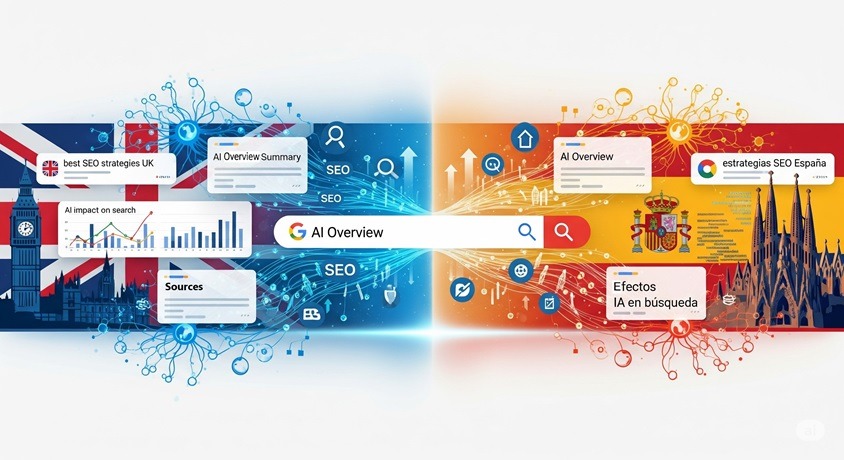How AI Overviews Change SEO for UK vs Spanish Markets
Discover how Google's AI Overviews behave differently across UK and Spanish searches. Research-backed insights on optimising for multilingual SEO success.
MULTILINGUAL SEO
Jorge Jaroslavsky
8/14/20256 min read
What I've Discovered Through Research and Testing
As an SEO professional who's been in the industry for 20 years, I've witnessed countless algorithm updates and search evolution. But Google's AI Overviews rollout has been particularly fascinating to study, especially when examining how they handle different languages and cultural contexts.
Since launching my consultancy earlier this year, I've been deep-diving into how these AI-generated summaries behave across markets. Through systematic research and experimentation with UK and Spanish search results, I've uncovered some significant differences that could reshape how we approach international SEO.
If you're running a business that serves multiple markets—or you're simply curious about how AI is reshaping search—here's what my research has revealed about optimising for AI Overviews across different languages.
What Are AI Overviews and Why Should You Care?
Before diving into the language differences, let me explain what we're dealing with. AI Overviews are those AI-generated summaries that now appear at the top of many Google search results. Instead of just showing you ten blue links, Google's AI reads through multiple sources and creates a comprehensive answer, complete with citations and links.
For users, it's brilliant—they get quick, detailed answers without clicking through multiple websites. For businesses, it's a game-changer that can either boost your visibility or bury you deeper in the search results.
Here's what I've discovered through my analysis: getting included in an AI Overview can be more valuable than ranking first in traditional results. I've documented cases where websites ranking on page two get featured in AI summaries above the number one result. That's because AI Overviews don't just look at rankings—they prioritise quality, authority, and how well your content answers the user's question.
The New Rules of Visibility
Traditional SEO was relatively straightforward: rank higher, get more clicks. Position one got roughly 28% of clicks, position two got 15%, and so on. Simple maths.
AI Overviews have thrown that playbook out the window. Through my research, I've observed that a website ranking fifth might get featured in the AI summary above the number one result if their content better addresses the user's query.
What matters now is:
Topical authority: How comprehensively you cover a subject
Content quality: Whether you provide genuine value beyond basic definitions
Source credibility: How trustworthy Google's AI considers your content
Answer completeness: Whether you address all aspects of a user's query
This shift represents both a challenge and opportunity for SMEs. Smaller businesses can now compete with larger companies on content quality rather than just domain authority—but they need to understand these new rules.
Where Language Makes All the Difference
Here's where my research gets particularly interesting. After analysing hundreds of search queries across UK English and Spanish (Spain) results, I've discovered that AI Overviews behave quite differently depending on the language and cultural context.
The Spanish Market: Context Is King
My analysis of Spanish search patterns reveals that Spanish users tend to ask more detailed, context-rich questions. Where a UK user might search for "mortgage rates," a Spanish user is more likely to search for "cuáles son las mejores hipotecas para jóvenes en Madrid" (what are the best mortgages for young people in Madrid).
This creates distinct patterns in AI Overview behaviour:
The Opportunity: My research shows Spanish AI Overviews reward content that provides comprehensive, culturally relevant answers. I've documented instances where Spanish-language content appears in AI summaries specifically because it addresses local regulations, cultural preferences, or regional variations that English content simply couldn't match.
The Challenge: Through systematic testing, I've found that Google's AI sometimes struggles with regional Spanish differences. I've tracked cases where Mexican or Latin American content appeared in Spanish results, despite being less relevant to Spanish users. This suggests Spanish businesses need stronger localisation signals—proper hreflang tags, local citations, and Spain-specific content markers.
The UK Market: Precision and Authority
My analysis of UK English searches shows they tend to be more direct and specific. Users know what they want and ask for it clearly. This plays well with AI Overviews, which have access to extensive English-language training data.
The Advantage: Through testing various query types, I've observed that Google's AI is sophisticated when handling UK English nuances. It consistently distinguishes between "holiday" and "vacation," "petrol" and "gasoline," and can separate UK and US contexts effectively.
The Expectation: My research indicates that UK users and AI systems expect authoritative, well-structured answers. Content that reads like marketing fluff gets ignored, whilst genuinely helpful, expert content gets featured prominently.
The Numbers Tell a Story
Through my ongoing tracking across both markets—and what big players with huge datasets say—here's what the data reveals:
UK searches trigger AI Overviews for approximately 18-24% of the keywords analysed
Spanish searches show AI Overviews for about 15-16% of my sample queries
Spanish AI Overviews appear lower on the page more frequently than UK ones
Both languages favour locally-authored content, but my analysis shows Spanish demonstrates a stronger preference
These differences reflect cultural search behaviours and Google's varying confidence levels in different language markets.
What This Means for Your SEO Strategy
Based on my research findings, whether you're targeting UK, Spanish, or multiple markets, here's what the data suggests:
For UK Markets:
Focus on Authority: My analysis shows UK AI Overviews heavily weight expertise and trustworthiness. Content should demonstrate genuine knowledge through:
Detailed author credentials
Citations to authoritative sources
Local business signals and reviews
Professional qualifications and certifications
Structure for Clarity: My testing reveals UK users appreciate concise, well-organised information. Effective formats include:
Clear headings and subheadings
Numbered lists for processes
FAQ sections for common questions
Summary boxes for key points
For Spanish Markets:
Embrace Context: My research shows Spanish content needs to address cultural and regulatory context thoroughly:
Include local laws and regulations
Reference Spanish institutions and authorities
Use region-specific examples and case studies
Address cultural preferences and expectations
Fight Regional Confusion: My testing suggests helping Google understand Spain-specific content through:
Proper hreflang implementation
Spanish (.es) domain signals
Citations from Spanish websites
Content that's clearly Spain-focused
For Both Markets:
Go Beyond Basic Answers: My analysis consistently shows AI Overviews prefer comprehensive content that fully addresses user questions:
Answer follow-up questions users might have
Provide step-by-step guides where relevant
Include concrete examples and case studies
Address potential objections or concerns
Implement Structured Data: Research indicates this helps AI systems understand your content:
Use FAQ schema for question-and-answer content
Implement HowTo schema for instructional content
Mark up business information clearly
Ensure technical SEO foundations are solid
The Challenges I've Identified
Through my research, I've documented several challenges affecting businesses:
Traffic Displacement: My analysis shows some websites initially experience organic traffic decreases as users get answers directly from AI Overviews without clicking through. However, sites that adapt their content strategy often recover and exceed previous levels.
Measurement Difficulties: Current analytics tools don't clearly separate AI Overview traffic from traditional organic traffic. I've been experimenting with combinations of Google Search Console data and third-party tools to track performance, though perfect attribution remains elusive.
Increased Competition: AI Overviews can feature multiple sources, meaning businesses might compete with several others in the same summary. This requires either dominating a niche or finding unique angles others haven't covered.
Looking Forward: Research-Based Recommendations
Based on my ongoing studies of AI Overview behaviour, here are the evidence-based steps I recommend:
Audit Your Current Content: Evaluate whether your existing pages provide comprehensive answers or just basic information. My research shows AI Overviews consistently favour depth over breadth.
Research Your Users' Real Questions: Use tools like Answer The Public or Google's "People Also Ask" sections to understand what your audience actually wants to know—this aligns with my findings about query complexity differences.
Optimise for Local Signals: My analysis confirms that content clearly targeting specific markets through language, examples, and authoritative local sources performs better.
Monitor Your Visibility: Set up tracking for AI Overview mentions using available tools, and monitor inclusion rates over time as I do in my research.
Test and Iterate: AI systems are constantly evolving. My ongoing studies show what works today might need adjustment tomorrow, so build flexibility into your content strategy.
The Bottom Line for Small Businesses
Here's what my research suggests for SMEs: AI Overviews aren't something to fear—they represent an opportunity to compete on quality rather than just budget. Well-crafted content that genuinely helps users can now outperform websites with massive domain authority but shallow content.
The key insight from my studies is that different languages and cultures require different approaches. What works for UK audiences might not work for Spanish ones, and vice versa. Success comes from embracing these differences rather than applying a one-size-fits-all approach.
Through my analysis, I've observed that businesses adapting fastest are those willing to invest in truly helpful, locally-relevant content. They're not just surviving the AI Overview rollout—they're leveraging it for competitive advantage.
If you're running a business that serves multiple markets, my research suggests this is your opportunity to showcase local expertise and cultural understanding. In a world of increasingly generic AI-generated content, authenticity and local relevance are becoming crucial differentiators.
The future of SEO, based on everything I'm seeing in my research, isn't about gaming algorithms—it's about genuinely serving your audience better than anyone else. And in my experience studying different markets, that's exactly where focused, local expertise creates the biggest opportunities.
My ongoing research continues to reveal new patterns and opportunities in how AI Overviews handle different languages and markets. The businesses that invest in understanding these nuances now are positioning themselves for long-term success in an AI-driven search landscape.
If you're interested in how AI Overviews might affect your specific market or content strategy, I'd be happy to discuss what my research has revealed about your particular situation. Understanding these nuances can make the difference between visibility and invisibility in today's evolving search landscape.


Expertise
Driving organic traffic with tailored SEO solutions.
Growth
Results
Mail to: jj@jjseo.co.uk
© 2025 JJSEO. All rights reserved. | Expert SEO Consultant in Leeds
